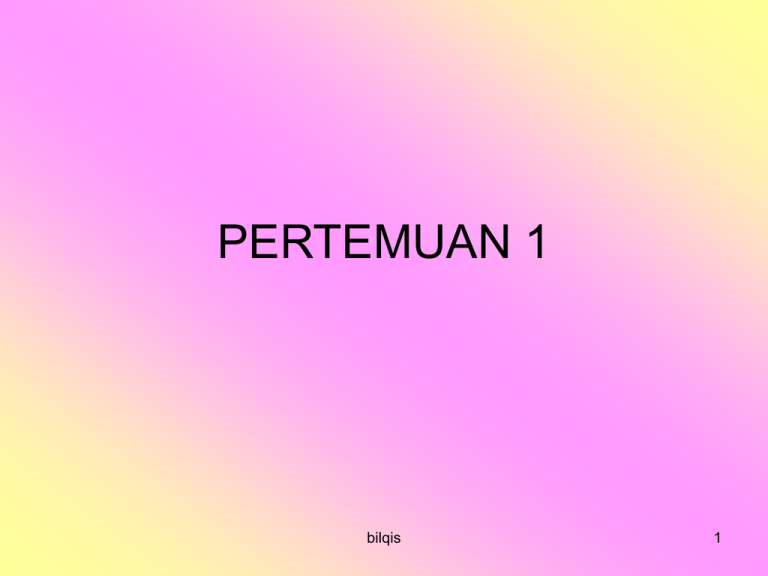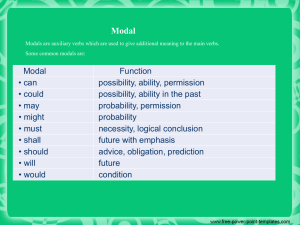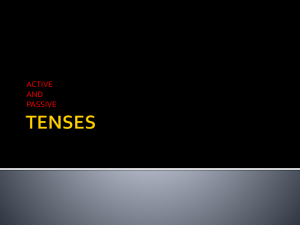Document
advertisement

PERTEMUAN 1
bilqis
1
TUJUAN INSTRUKSIONAL KHUSUS
Setelah menyelesaikan
mahasiswa diharapkan :
pertemuan
ini
– Mengetahui definisi Sistem Persamaan Linier
– Dapat membentuk matriks yang merepresentasikan Sistem
Persamaan Linier
– Dapat menyelesaikan Sistem Persamaan Linier dengan
menggunakan metode Gauss dan Gauss Jordan
bilqis
2
Contoh Soal berapa nilai x, y
dan Z
x + y + 2z = 9
2x + 4y – 3z = 1
3x + 6y – 5z = 0
bilqis
3
Sistem Persamaan Linier
bilqis
4
Persamaan linier :
Persamaan yang semua variabelnya berpangkat 1 atau 0 dan
tidak terjadi perkalian antar variabelnya.
Contoh:
(1)
x + y + 2z = 9
PL
(2)
2x + y = 9
PL
(3)
2xy – z = 9
Bukan PL
Solusi PL (1) : berupa suatu “tripel” dengan masing-masing
nilai sesuai urutan (nilai-x, nilai-y, nilai-z) yang memenuhi
persamaan tersebut.
Himpunan solusi untuk persamaan (1) di atas:
{ … ( 0, 1, 4), (1, 0, 4), (4, 5, 0), …. }
Himpunan solusi juga disebut Ruang Solusi (solution space)
bilqis
5
Misal :
z t 0
y s5
x 9 s 2t 4
atau
xt 4
y s 5
9t s
z
0
2
atau
xt 4
z s0
y 9 2s t 5
terserah variable mana yang akan diumpamakan, rumus
bilqis
berbeda, tapi hasil akhir untuk
x, y, dan z tetap sama
6
Sistem Persamaan Linier:
Suatu sistem dengan beberapa (2 atau lebih) persamaan linier.
Contoh:
x + y = 3
3x – 5y = 1
Ruang Solusi:
berupa semua ordered-pair (nilai-x, nilai-y) yang harus
memenuhi semua persamaan linier dalam sistem tersebut;
untuk sistem ini ruang solusinya { (2, 1) }
bilqis
7
PENYIMPANGAN PADA PENYELESAIAN SUATU SPL
Pada beberapa SPL tertentu terdapat penyimpangan – penyimpangan
dalam penyelesaiannya, misal :
Diberikan SPL sebagai berikut :
x1 + 1/2x2 + 1/3x3 = 1
1/2x1 + 1/3x2 + 1/4x3 = 0
1/3x1 + 1/4x2 + 1/5x3 = 0
Didapat penyelesaian x1 = 9, x2 = -36, dan x3 = 30
Jika SPL tersebut dituliskan dalam bentuk dua desimal :
x1 + 0,5x2 + 0,33x3 = 1
0,5x1 + 0,33x2 + 0,25x3 = 0
0,33x1 + 0,25x2 + 0,2x3 = 0
Didapat penyelesaian x1 ≈ 55,55;bilqis
x2 ≈ -277,778; dan x3 ≈ 255,556
8
Interpretasi Geometrik:
Sistem menggambarkan 2 garis lurus pada sebuah bidang datar.
g1:
x + y = 3
g2:
3x – 5y = 1
Solusi: g1 dan g2 berpotongan di (2, 1)
Kemungkinan:
berpotongan di 1 titik
Var => sama
Konst => tidak
Kelipatan
X+y = 5
X+y = 5
X+y = 7
2X+2y = 10
tidak
berpotongan
bilqis
berimpit
9
Solusi Sistem Persamaan Linier
a. Cara Biasa → Seperti SMA
b. Eliminasi Gauss
c. Eliminasi Gauss - Jordan
a. Cara Biasa (untuk mengingat kembali):
I.
x + y = 3 3x + 3y = 9
3x – 5y = 1 3x – 5y = 1
8y = 8
y =1
3x – 5 = 1 3x = 6 x = 2
II.
y=3–x
3x – 5(3 – x) = 1 atau 3x – 15 + 5x = 1 8x = 16 x = 2
y=3–x y= 1
bilqis
10
b. Eliminasi Gauss (ringkasan):
Sistem Persamaan →
Linier
Matriks
Augmented
→
Eliminasi → Substitusi
Gauss
Balik
OBE
bilqis
11
Penyelesaian Sistem Persamaan Linier
b. Eliminasi Gauss
(lihat contoh 3, halaman 5)
x + y + 2z = 9
2x + 4y – 3z = 1
3x + 6y – 5z = 0
ditulis
dalam
bentuk
matriks
augmented
lalu diusahakan berbentuk
1 1 2
9
2 4 -3
1
3 6 -5
0
1 1 2
9
0 1 ?
?
0 0 1
?
dengan proses Operasi Baris Elementer (OBE)
(Elementarybilqis
Row Operation - ERO)
12
Matriks Augmented : (Matriks yang diperbesar)
Matriks yang entri-entrinya dibentuk dari koefisien-koefisien
Sistem Persamaan Linier
Contoh :
x + y + 2z = 9
2x + 4y – 3z = 1
3x + 6y – 5z = 0
Matriks Augmented-nya :
bilqis
1
1
2
9
2
4
-3
1
3
6
-5
0
13
O.B.E
sebuah baris dengan kostanta 0
sebuah baris dengan konstanta 0
kemudian pada baris lain
Menukar dua buah baris
Ciri-ciri eliminasi Gauss (Eselon Baris)
Jika suatu baris tidak semua nol, maka bilangan
pertama yang tidak nol adalah 1 (1 utama)
Baris nol terletak paling bawah
1 utama baris berikutnya berada di kanan 1
utama baris di atasnya.
bilqis 0
14
Dibawah 1 utama harus
Contoh : 1
0
0
4
3
1
6
0
1
7
2
5
0
0
0
1
2
6
0
0
1
0
1
0
0
0
1
Ciri-ciri eliminasi Gauss Jordan (Eselon Baris
Tereduksi)
Jika suatu baris tidak semua nol, maka bilangan
pertama yang tidak nol adalah 1 (1 utama)
Baris nol terletak paling bawah
1 utama baris berikutnya berada di kanan 1utama
baris diatasnya..
Tiap kolom yang mengandung 1 utama mempunyai
nol di tempat lain
1
0
Contoh :
0
0
0
1
0
0
1
4
7
1
0
0
0
bilqis
1
2
0
0
0
1
0
0
0
1
3
0
15
Eliminasi Gauss menggunakan O.B.E :
9
1 1 2
0 2 7 17
0 3 11 27
[baris 1 -2] + baris 2
1
1
2
9
*
2
2
2
2
2
+ 4
3
1
=
[baris 1 -3] + baris 3
baris 2 * 1/2
9
1 1 2
0 1 7 / 2 17 / 2
0 0 1 / 2 3 / 2
1
1
2
9
*
3
3
3
3
+
3
6
5
0
0
3
= 11
27
[baris 2 -3] + baris 3
0
1
7/2
17 / 2
*
3
3
3
3
0
3
11
27
+
0
0
1/ 2
3 / 2
=
Substitusi Balik
baris 3 -2
1 1 2
7
0 1 2
0 0 1
0
2
7
17
9
17
2
3
z=3
7
y z 17 / 2
2
y 7 / 2(3) 17 / 2
y2
x y 2z 9
x 2 2(3) 9
x 1
bilqis
x 1, y 2, z 3
16
x
y
z
1
0
0
1
2
0
2
-7
-½
9
-17
-3/2
1
0
0
1
2
0
2
-7
-½
9
-17
-3/2
1
0
0
1
2
0
2
-7
-½
9
-17
-3/2
Substitusi Balik:
-1/2 z = -3/2
z =3
z
2y – 7z = - 17
2y = 21 – 17
y=2
y
x + y + 2z = 9
x =–2–6+9
x =1
z
bilqis
17
Bentuk eselon baris:
1. Entri-entri dalam sebuah baris tidak semuanya nol, maka
entri pertama yang tidak nol harus 1 (disebut 1-utama /
leading-1)
2. Baris-baris yang semua entrinya 0, dikelompokkan di bagian
bawah matriks
3. Posisi 1-utama dari baris yang lebih bawah harus lebih ke
kanan d/p 1-utama baris yang lebih atas
Bentuk eselon baris tereduksi:
1, 2, 3, ditambah
4. Semua entri (yang lain) dari kolom yang berisi 1-utama
harus di-0-kan
bilqis
18
Operasi Baris Elementer (OBE)
(Elementary Row Operation - ERO)
Perhatikan bahwa tiap baris dari matriks merepresentasikan persamaan linier
1.
2.
3.
Mengalikan suatu baris dengan bilangan nyata k 0
Menukar posisi dua baris
Menambah baris-i dengan k kali baris-j
bilqis
19
c. Eliminasi Gauss-Jordan (ringkasan):
Sistem Persamaan →
Linier
Matriks
Augmented
→
Eliminasi
Gauss-Jordan
→
Solusi
(langsung)
OBE
bilqis
20
Eliminasi Gauss-Jordan
(contoh yang sama)
x + y + 2z = 9
1 1 2
9
2x + 4y – 3z = 1
2 4 -3
1
3x + 6y – 5z = 0
3 6 -5
0
dan diusahakan berbentuk
1 0 0
0 1 0
?
?
0 0 1
?
dengan proses Operasi Baris Elementer (OBE)
(Elementary Row Operation - ERO)
bilqis
21
Gauss-Jordan MatLab
bilqis
22
Eliminasi Gauss-Jordan menggunakan O.B.E
idem Gauss
disambung dengan :
2
9
1 1
0 1 7 / 2 17 / 2
0 0
1
3
1 1 2 9
0 1 0 2
0 0 1 3
1 1 0 3
0 1 0 2
0 0 1 3
1 0 0 1
0 1 0 2
0 0 1 3
baris 3
0
0
1
3
baris 3
baris 2
*
7 + baris 2
2
7 / 2
7 / 2
7 / 2
7 / 2
0
1
7/2
17 / 2
+
-2 + baris 1
-1 + baris 3
x 1
y 2
z 3
bilqis
=
0
1
0
2
0
0
1
3
0
1
0
2
*
*
2
2
2
2
1
1
1
1
+
1
1
2
9
1
1
0
3
+
1
1
0
3
=
1
0
0
1
=
23
Suatu SPL mempunyai 3 kemungkinan jawaban, yaitu :
1.
Mempunyai jawaban tunggal
2.
Mempunyai banyak jawaban
3.
Tidak mempunyai jawaban
Contoh :
Tentukan nilai a agar SPL berikut:
x – 2y + 3z = 1
2x – 3y + 9z = 4
x – 3y + (a2 - 4)z = 1 + a
i.
ii.
iii.
Mempunyai jawaban tunggal
Mempunyai banyak jawaban
Tidak mempunyai jawaban
bilqis
24
Penyelesaian :
Matriks Eselon SPL di atas adalah :
3
1 2
0 1
3
0 0 4 a 2
i.
Mempunyai jawaban tunggal
a2 – 4 ≠ 0 a ≠ -2 dan a ≠ 2
ii.
Mempunyai banyak jawaban
a2 – 4 = 0 dan a +2 = 0 a = -2
iii.
Tidak mempunyai jawaban
a2 – 4 = 0 dan a + 2 ≠ 0 a = 2
bilqis
1
2
2 a
25
• Lihat contoh di halaman 5 dan 6
• Lihat contoh di halaman 11 dan 12
bilqis
26
Halaman 5
Example 3.
In the left column below we solve a system of equations by operating on
the equations in the system, and in the right column we solve the same
system by operating on the rows of the augmented matrix.
1
2
3
x + y + 2z = 9
2x + 4y – 3z = 1
3x + 6y -5z = 0
Add -2 times the first equation
to the second to obtain
1
2
4
6
3
5
9
1
0
Add -2 times the first row
to the second to obtain
9
1 1 2
0 2 7 17
3 6 5
0
x + y + 2z = 9
2y – 7z = -17
3x + 6y -5z = 0
Add -3 times the first equation
to the third to obtain
Add -3 times the first row
to the third to obtain
9
1 1 2
0 2 7 17
0 3 11 27
x + y + 2z = 9
2y – 7z = -17
3y -11z = -27
bilqis
27
Multiply the second equation
by ½ to obtain
Multiply the second row by
½ to obtain
x y 2z 9
y
7
17
z
2
2
3 y 11z 27
1 1 2
9
7
17
0
1
2
2
0 3 11
27
Add -3 times the second
equation to the third to obtain
Add -3 times the second
row to the third to obtain
x y 2z 9
7
17
y z
2
2
1
3
z
2
2
1 1 2
7
0 1
2
0 0 1
2
Multiply the third equation by
-2 to obtain
Multiply the third row by -2
to obtain
x y 2z 9
1 1 2
7
0 1 2
0 0 1
7
17
z
2
2
z 3
y
bilqis
9
17
2
3
2
9
17
2
3
28
Add -1 times the second equation
to the first to obtain
Add -1 times the second
row to the first to obtain
x
11
35
z
2
2
7
17
y z
2
2
z3
11
1
0
2
7
0 1
2
0
0
1
Add -11/2 times the third equation to
the first and 7/2 times the third
equation to the second to obtain
Add -11/2 times the third row to the
first and 7/2 times the third row to
the second to obtain
x 1
y2
z3
35
2
17
2
3
1 0 0 1
0 1 0 2
0 0 1 3
The solution : x = 1, y = 2, z = 3
bilqis
29
Halaman 11
0 0 2 0 7 12
2 4 10 6 12 28
2 4 5 6 5 1
Step 1. Locate the leftmost column that does not
consist entirely of zeros.
0 0 2 0 7 12
2 4 10 6 12 28
2 4 5 6 5 1
Leftmost nonzero column
Step 2. Interchange the top row with another row, if necessary, to
bring a nonzero entry to the top of the column found in Step 1.
2 4 10 6 12 28
0 0 2 0 7 12 The first and second rows in the
preceding matrix were interchanged
2 4 5 6 5 1
bilqis
30
Step 3
if the entry that is now at the top of the coloumn found in step 1 is
a, multiply the first row by 1/a in order to introduce a leading 1
1
0
2
step 4
-5
-2
-5
3
0
6
6 14
7 12
-5 -1
The first row of the
preceding
matrix was multiplied by ½
add suitable multiples of the top row to the rows below so that all
entries below the leading 1 to zeros
1
0
0
step 5
2
0
4
2
0
0
-5
-2
5
3
0
0
6 14
7 12
-17 -29
-2 times the first row
of the preceding matrix was
added to the third row
Now cover the top row in the matrix and begin again with step 1
applied to the submatrix that remains. Continue in this way until
the entire matrix is in row-echelon form
1
0
0
2
0
0
-5
-2
5
3
0
0
6 14
7 12
-17 -29
left most nonzero coloumn in the
submatrix
bilqis
31
1
0
0
1
0
0
1
0
0
2
0
0
2
0
0
2
0
0
-5
1
5
-5
1
5
-5
1
0
3
0
0
6
-3,5
-17
3
0
0
3
0
0
6
-3,5
-17
6
-3,5
0.5
14
-6
29
14
-6
29
14
-6
1
The first row in the submatrix
was multiplied
by -1/2 to introduce a leading 1
-5 times the first row of the submatirx
was added to the second row of the submatrix
to introduce a zero below the leading 1
The top row in the submatrix was
covered, and we returned again
to the step 1
leftmost non zero coloumn
in the new submatrix
1
0
0
2
0
0
-5
1
0
3
0
0
6
-3,5
1
14
-6
2
The first(and only) row in the submatrix
was multiplied by 2 to introduce a leading 1
•The entire matrix is now in row-echelonform. To find the reduce row-echelon
form we need the following additional step
bilqis
32
Step 6
Begining with the last nonzero row and working upward, add suitable
multiplies of each row to the rows above to introduce zeros above the
leading 1’s
1
0
0
2
0
0
-5
1
0
3
0
0
6
0
1
14
1
2
7/2 times the third row of the
preceding matrix was added
to the second row
1
0
0
2
0
0
-5
1
0
3
0
0
0
0
0
2
1
1
-6 times the third row was
added
to the first row
1
0
0
2
0
0
0
1
0
3
0
0
0
0
1
7
1
2
5 times the second row was
added to the first row
The last matrix is in reduced row echelon form
bilqis
33
Sistem Persamaan Linier Homogen :
1.
Sistem Persamaan Linier dikatakan homogen jika semua suku di
kanan tanda “=“ adalah 0.
2.
Solusi Sistem Persamaan Linier Homogen:
Solusi Trivial ( semua xi = 0; i = 1 .. n ): pasti ada
Solusi Non-trivial ( solusi trivial, plus solusi di mana ada xi ≠ 0 )
Contoh: lihat contoh 6 halaman 18 dan verifikasi proses penyelesaiannya
2
2
-1
0
1
0
-1
-1
2
-3
1
0
1
1
-2
0
-1
0
0
0
1
1
1
0
bilqis
34
Contoh: lihat contoh 6 halaman 18 dan verifikasi proses penyelesaiannya
2
-1
1
0
1
-1
1
0
2
-1
1
0
1
-1
1
0
-1
2
-2
1
-1/2
2
-2
1
1
1
-1/2
0
0
3/2
0
0
0
0
0
-3
0
1
0
-3
0
1
1
1
-1
1
0
0
0
0
1/2
1
-1
1
0
0
0
0
0
1/2
0
-3
3/2
0
-3/2
0
-3/2
0
1
1
1
0
bilqis
Brs-1 (1/2)
Brs-2 + brs-1
Brs-3 – brs-1
35
1
1
-1/2
0
1/2
0
0
0
3/2
-3
3/2
0
0
0
-3/2
0
-3/2
0
0
0
1
1
1
0
1
1
-1/2
0
1/2
0
0
0
1
-2
1
0
0
0
1
0
1
0
Brs-2 (2/3)
Brs-3 (– 2/3)
Brs-3 – brs-2
Brs-4 – brs-2
0
0
1
1
1
-1/2
0
0
0
0
1
1
0
0
1/2
0
1
-2
1
0
0
0
2
0
0
0
0
3
0
0
bilqis
36
1
1
-1/2
0
1/2
0
0
0
1
-2
1
0
0
0
0
2
0
0
0
0
0
3
0
0
1
1
-1/2
0
1/2
0
0
0
1
-2
1
0
0
0
0
1
0
0
Brs-3 (1/2)
Brs-4 (1/3)
Brs-4 – brs-3
0
0
0
1
0
0
1
1
-1/2
0
1/2
0
0
0
1
-2
1
0
0
0
0
1
0
0
0
0
0
0
0
bilqis
0
37
1
1
-1/2
0
1/2
0
0
0
1
-2
1
0
0
0
0
1
0
0
0
0
0
0
0
0
1
1
-1/2
0
1/2
0
0
0
1
0
1
0
0
0
0
1
0
0
0
0
0
0
0
0
1
1
0
0
1
0
0
0
1
0
1
0
0
0
0
1
0
0
0
0
0
0
0
0
bilqis
baris-1 + (1/2) baris-2
38
1
1
0
0
1
0
0
0
1
0
1
0
0
0
0
1
0
0
0
0
0
0
0
0
x1 + x2
+ x5 = 0
x3
+ x5 = 0
x4
=0
x5 = s x3 + x5 = 0 x3 = – x5
x2 = t x1 + x2 + x5 = 0 x1 = – x2 – x5
Ruang solusinya = { (-t-s, t, -s, 0, s ) }
Catt => yang diumpamakan dahulu bilqis
adalah index terbesar
39
Teorema:
Sistem Persamaan Linier Homogen dengan variabel
lebih banyak d/p. persamaan mempunyai tak
berhingga banyak pemecahan.
Ditinjau dari matriksnya:
Sistem Persamaan Linier Homogen dengan kolom lebih banyak
d/p. baris mempunyai tak berhingga banyak pemecahan.
bilqis
40
Contoh menggunakan Matlab
• Soal
x + y + 2z = 9
2x + 4y – 3z = 1
3x + 6y – 5z = 0
Buat matrix pada Matlab
bilqis
41
Matlab
Mengenol-kan baris ke-2, kolom 1
Baris 2 = Baris 1 * -2 + baris 2
bilqis
42
Matlab
Mengenol-kan baris ke-3, kolom 1
Baris 3 = Baris 1 * -3 + baris 3
bilqis
43
Matlab
Membuat nilai 1 pada kolom 2 dan baris 2
Baris 2 = Baris 2 * 1/2
bilqis
44
PR
• Contoh pada slide 3, coba tukar antara
baris pertama dengan baris 3, apakah
hasilnya tetap sama ? Jawab dengan
menggunakan Gauss-Jordan (dgn tangan)
x+ y
+ 2z =
9
2x +
4y –
3z =
1
3x +
6y –
5z =
0
bilqis
2x +
4y –
3z =
45
PR
• Contoh pada slide 8, coba kerjakan 2 SPL
yang seharusnya jawabannya sama, tapi
kenapa berbeda? Jawab dengan
menggunakan Gauss-Jordan (dengan
tangan)
x1 + 1/2x2 + 1/3x3 = 1
1/2x1 + 1/3x2 + 1/4x3 = 0
1/3x1 + 1/4x2 + 1/5x3 = 0
x1 + 0,5x2 + 0,33x3 = 1
0,5x1 + 0,33x2 + 0,25x3 = 0
0,33x1 + 0,25x2 + 0,2x3 = 0
bilqis
46
PR kerjakan 2 saja
• 1.1 3.b, 4.c, 5.d, 11
• 1.2 6.b, 7.c, 8.a, 13.b, 14.c, 15.b, 17,
22
bilqis
47






